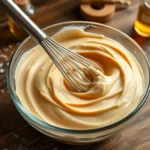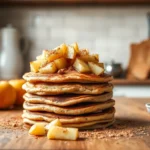We’ve all been there – craving warm, buttery biscuits but feeling overwhelmed by long ingredient lists and complicated techniques. That’s exactly why we’re obsessed with these 2 ingredient biscuits that’ll revolutionize your baking game forever. With just self-rising flour and heavy cream, you’ll create fluffy, tender biscuits that taste like they came from your grandmother’s kitchen.
These aren’t just any ordinary biscuits – they’re a game-changer for busy weeknights, unexpected guests, or those moments when you need fresh bread on the table fast. We’re talking about biscuits that come together in under 5 minutes of prep time and bake to golden perfection in just 15 minutes.
The best part? You don’t need to be a seasoned baker to master this recipe. We’ll show you how these simple ingredients transform into bakery-quality biscuits that’ll have everyone asking for your secret. Trust us, once you try this method, you’ll never go back to complicated biscuit recipes again.
Ingredients
We keep this recipe incredibly simple with just two pantry staples that create magic together. Our ingredient list couldn’t be shorter or more straightforward.
For 8 biscuits:
- 2 cups self-rising flour
- 1 cup heavy cream (cold)
That’s it! We love how these two ingredients work together to create tender biscuits without the need for butter, shortening, or multiple mixing steps. The self-rising flour provides the leavening power while the heavy cream adds richness and creates the perfect texture.
Make sure your heavy cream is cold straight from the refrigerator. Cold cream helps create flakier layers in our finished biscuits. We recommend checking the expiration date on your self-rising flour since older flour can lose its leavening power over time.
Store-bought self-rising flour works perfectly for this recipe. If you only have all-purpose flour on hand, you can make your own self-rising flour by combining 1 cup all-purpose flour with 1½ teaspoons baking powder and ½ teaspoon salt for each cup needed.
Equipment Needed

Creating these simple biscuits requires minimal kitchen equipment that most home bakers already have on hand. We’ve found that having the right tools makes the process even smoother and ensures consistent results every time.
Large Bowl serves as our primary mixing vessel for combining the two ingredients. The bowl should be spacious enough to allow gentle folding without flour flying everywhere during the mixing process.
Spoon or Whisk helps us blend the flour and cream together without overworking the dough. A wooden spoon works particularly well for this gentle mixing technique that keeps our biscuits tender.
Baking Sheet provides the foundation for baking our shaped biscuits. We recommend using a standard rimmed baking sheet that can accommodate 8 to 10 biscuits with adequate spacing between each one.
Parchment Paper lines our baking sheet and prevents the biscuits from sticking while ensuring easy cleanup afterward. This barrier also promotes even browning on the bottom of each biscuit.
Oven completes our essential equipment list and should be preheated according to your chosen recipe variation. The temperature will vary between 350°F for yogurt-based biscuits and 450°F for cream-based versions.
| Equipment | Purpose | Alternative Option |
|---|---|---|
| Large Bowl | Mixing ingredients | Medium bowl works for smaller batches |
| Spoon/Whisk | Gentle combining | Fork can substitute in pinch |
| Baking Sheet | Baking surface | Cast iron skillet for rustic style |
| Parchment Paper | Non-stick surface | Light greasing with butter |
| Oven | Baking heat source | Toaster oven for small batches |
We appreciate that this streamlined equipment list eliminates the need for pastry cutters, rolling pins, or specialized biscuit tools that traditional recipes often require.
Instructions
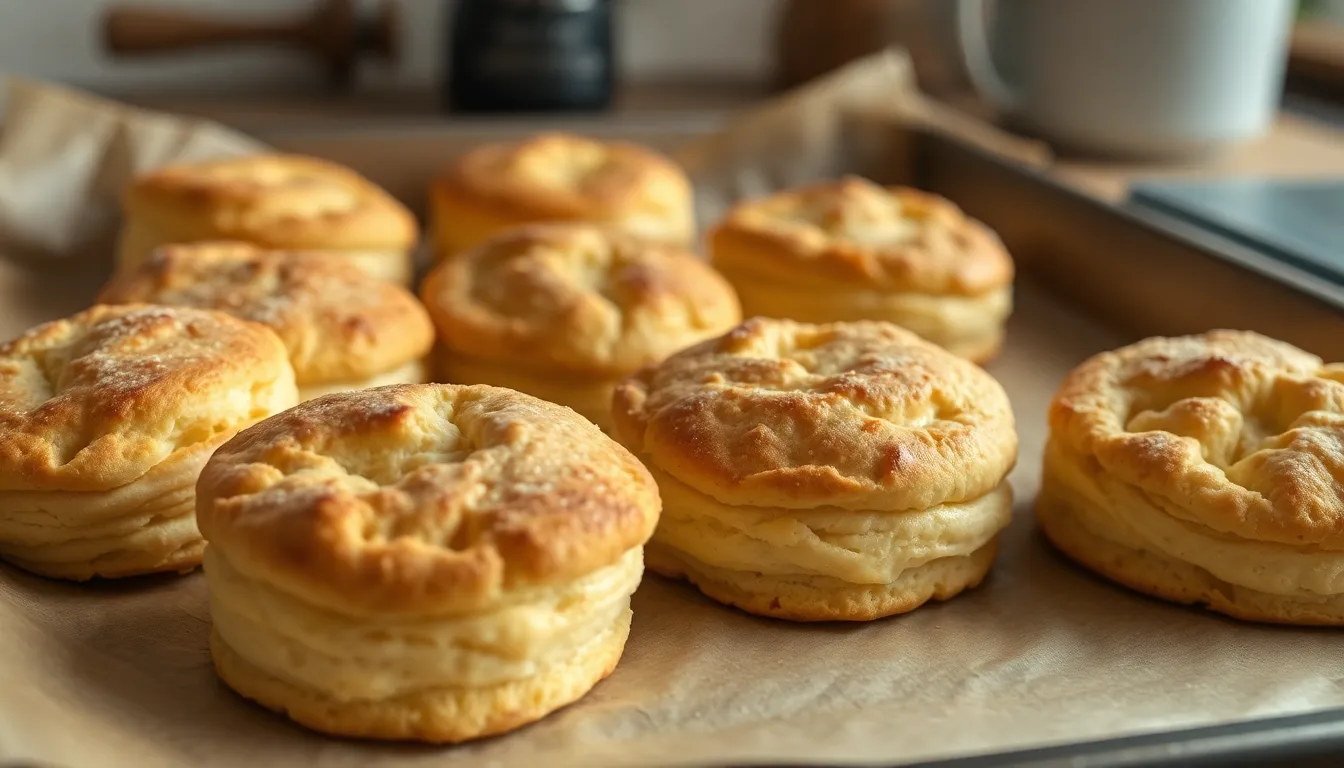
We’ll walk you through the simple process of creating these delicious biscuits in just three easy steps. Our straightforward method ensures perfect results every time.
Prep the Dough
Start by preheating your oven to 500°F (260°C) for optimal results. Place 2 cups of self-rising flour in your large mixing bowl and create a small well in the center. Pour 1 cup of cold heavy cream into the well and gently mix with a spoon until the dough just comes together. We want to avoid overworking the mixture to maintain the tender texture. Stop mixing as soon as no dry flour remains visible in the bowl.
Shape the Biscuits
Turn the slightly sticky dough onto a lightly floured surface using a spoon or spatula. Gently pat the dough with your hands to about ½ inch thickness without pressing too firmly. Fold the dough over once to create natural layers that will contribute to the biscuits’ flakiness. Use a round biscuit cutter or clean drinking glass to cut straight down through the dough without twisting. We recommend cutting biscuits close together to minimize waste and rerolling scraps gently for additional biscuits.
Bake the Biscuits
Place the cut biscuits on your parchment lined baking sheet with sides barely touching for soft edges. Position the baking sheet in the center of your preheated oven for even heat distribution. Bake for 10 to 12 minutes until the tops turn golden brown and the biscuits have risen nicely. Remove from the oven when they spring back lightly when touched and serve immediately for the best texture and warmth.
Tips for Perfect 2 Ingredient Biscuits

Measuring your flour accurately makes all the difference in achieving light, fluffy biscuits. We recommend sifting or fluffing your self-rising flour before measuring to prevent dense, heavy results. Dense biscuits often result from packed flour that weighs more than intended.
Cold heavy cream creates the flakiest texture we’ve found in our testing. Store your cream in the refrigerator until ready to use, as chilled cream helps create those coveted flaky layers. Room temperature cream won’t provide the same structural benefits during baking.
Gentle mixing prevents tough, chewy biscuits that disappoint at the dinner table. We mix our ingredients just until they come together, avoiding the temptation to overmix the dough. Stopping as soon as the mixture holds together preserves the tender crumb.
| Temperature Range | Baking Time | Results |
|---|---|---|
| 475°F (245°C) | 12-14 minutes | Golden, slightly longer bake |
| 500°F (260°C) | 10-12 minutes | Quick, golden brown finish |
Straight downward pressure when cutting biscuits ensures proper rise during baking. We never twist our biscuit cutter, as this seals the edges and prevents the biscuits from reaching their full height. Clean cuts allow steam to escape properly.
Flour your work surface and hands lightly to manage the naturally sticky dough. This sticky consistency indicates proper hydration, so resist adding extra flour beyond what’s needed for handling. Too much additional flour alters the recipe balance.
Brushing finished biscuits with melted butter adds an extra layer of richness and flavor. We apply this optional step immediately after removing biscuits from the oven while they’re still hot. The butter soaks in beautifully and creates an appealing golden sheen.
Variations and Add-Ins
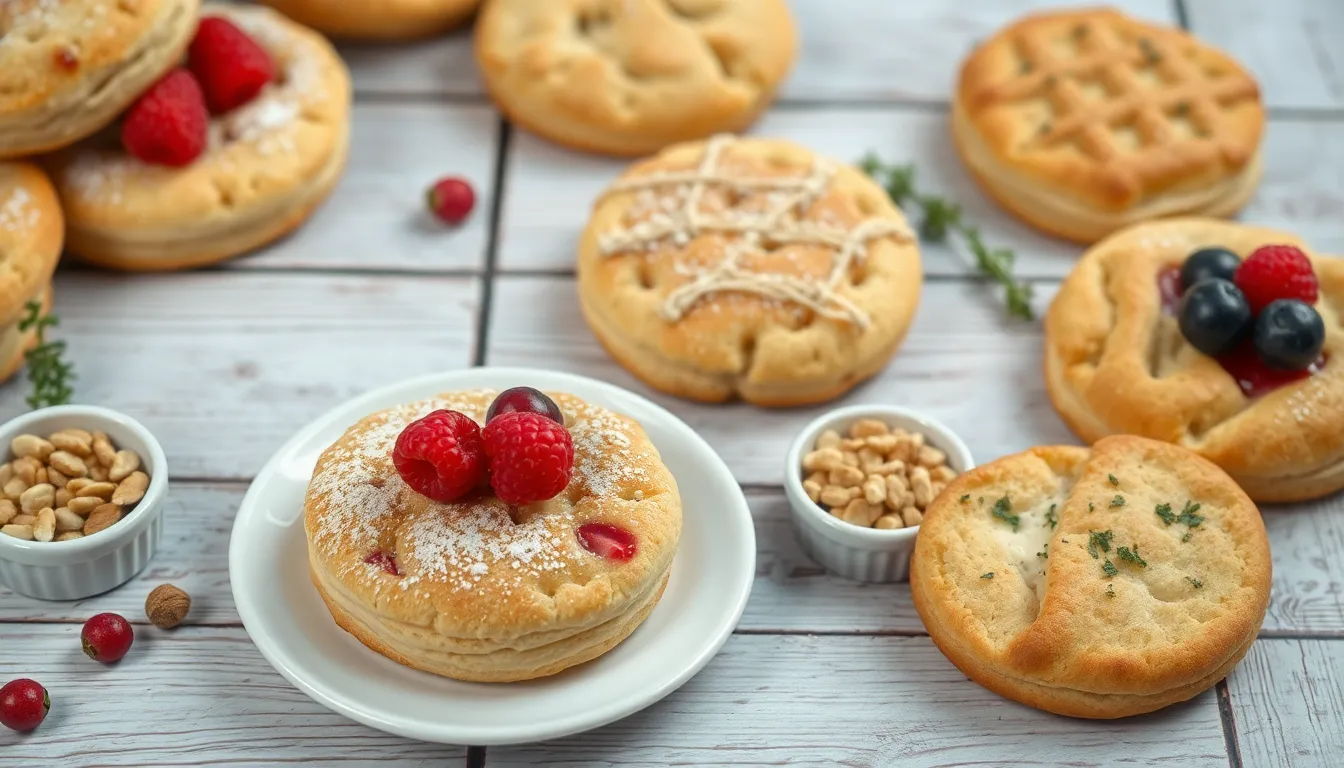
The beauty of our 2 ingredient biscuit recipe lies in its versatility and endless customization possibilities. These simple additions transform our basic biscuits into exciting new flavors without complicating the process.
Sweet Variations
We can create delicious sweet shortcake biscuits by adding 2 tablespoons of granulated sugar to our flour and cream mixture. This small addition transforms our biscuits into perfect bases for strawberry shortcake or summer berry desserts.
Fresh fruit toppings elevate these sweet biscuits to bakery quality desserts. We recommend serving them with sliced strawberries, fresh blueberries, or mixed seasonal berries. The natural sweetness of the fruit pairs beautifully with the tender, slightly sweet biscuit base.
For extra indulgence, we can brush the tops with melted butter and sprinkle with cinnamon sugar before baking. This creates a golden, slightly crispy exterior that contrasts wonderfully with the soft interior.
Savory Variations
Cheese biscuits rank among our favorite savory variations. We fold ½ cup of shredded sharp cheddar or Parmesan cheese into the dough after mixing the flour and cream. The cheese melts during baking and creates pockets of rich, savory flavor throughout each biscuit.
Herb biscuits bring fresh garden flavors to our simple recipe. We add 2 tablespoons of chopped fresh herbs like chives, rosemary, or thyme to the dough. These herbs infuse the biscuits with aromatic qualities that complement soups, stews, or breakfast dishes perfectly.
Spiced variations add warmth and complexity to our basic recipe. We incorporate ½ teaspoon of garlic powder, paprika, or dried herbs like oregano for Mediterranean flavors. These additions create biscuits that pair excellently with savory meals or work as standalone snacks.
For added texture, we can fold in ¼ cup of chopped nuts like pecans or walnuts, or sprinkle sesame seeds on top before baking. These additions provide delightful crunch and visual appeal to our finished biscuits.
Serving Suggestions
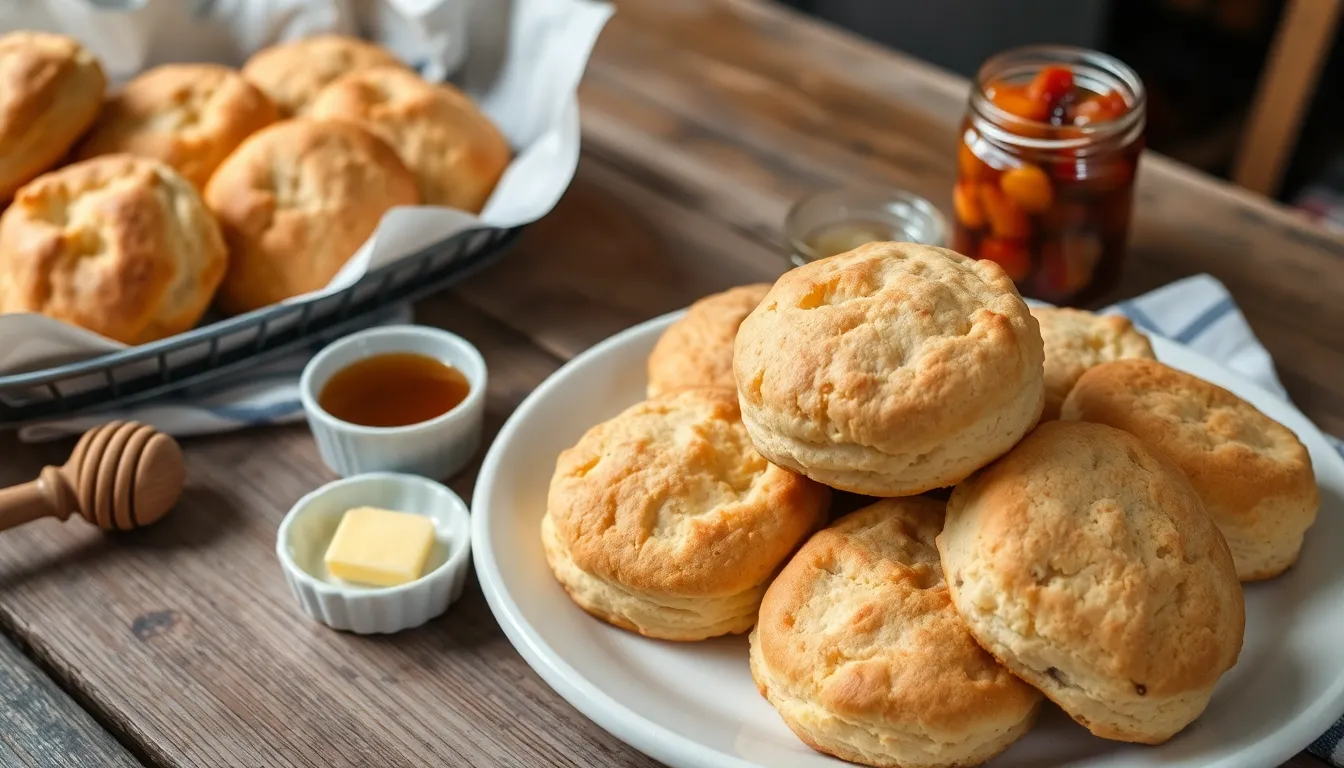
These fluffy 2-ingredient biscuits shine brightest when served warm from the oven. We recommend splitting them open and slathering with butter while they’re still steaming for the ultimate comfort food experience. The heat melts the butter instantly creating a rich and indulgent treat.
Breakfast becomes extraordinary when we pair these biscuits with honey or your favorite jam. Strawberry preserves complement the subtle sweetness while orange marmalade adds a citrusy brightness. We love drizzling pure maple syrup over split biscuits for a Southern inspired morning meal.
Transform lunch or dinner by using these biscuits as the perfect accompaniment to hearty soups and stews. The tender crumb soaks up savory broths beautifully making each bite satisfying. We particularly enjoy serving them alongside chicken and dumplings or beef stew for a comforting meal.
Create elegant appetizers by cutting the biscuits into smaller rounds before baking. These mini versions work wonderfully for brunch spreads or dinner parties. We suggest topping them with cream cheese and smoked salmon or creating small breakfast sandwiches with scrambled eggs and bacon.
Weekend brunches call for biscuits topped with sausage gravy or used as the base for eggs Benedict. The neutral flavor profile makes them versatile enough to handle both sweet and savory applications. We recommend keeping a batch warm in a low oven when serving guests so everyone enjoys them at their peak texture.
For dessert applications these biscuits serve as an excellent foundation for strawberry shortcake. Layer them with fresh berries and whipped cream for a classic American dessert. We also enjoy them with vanilla ice cream and fresh peach compote during summer months.
Storage Instructions
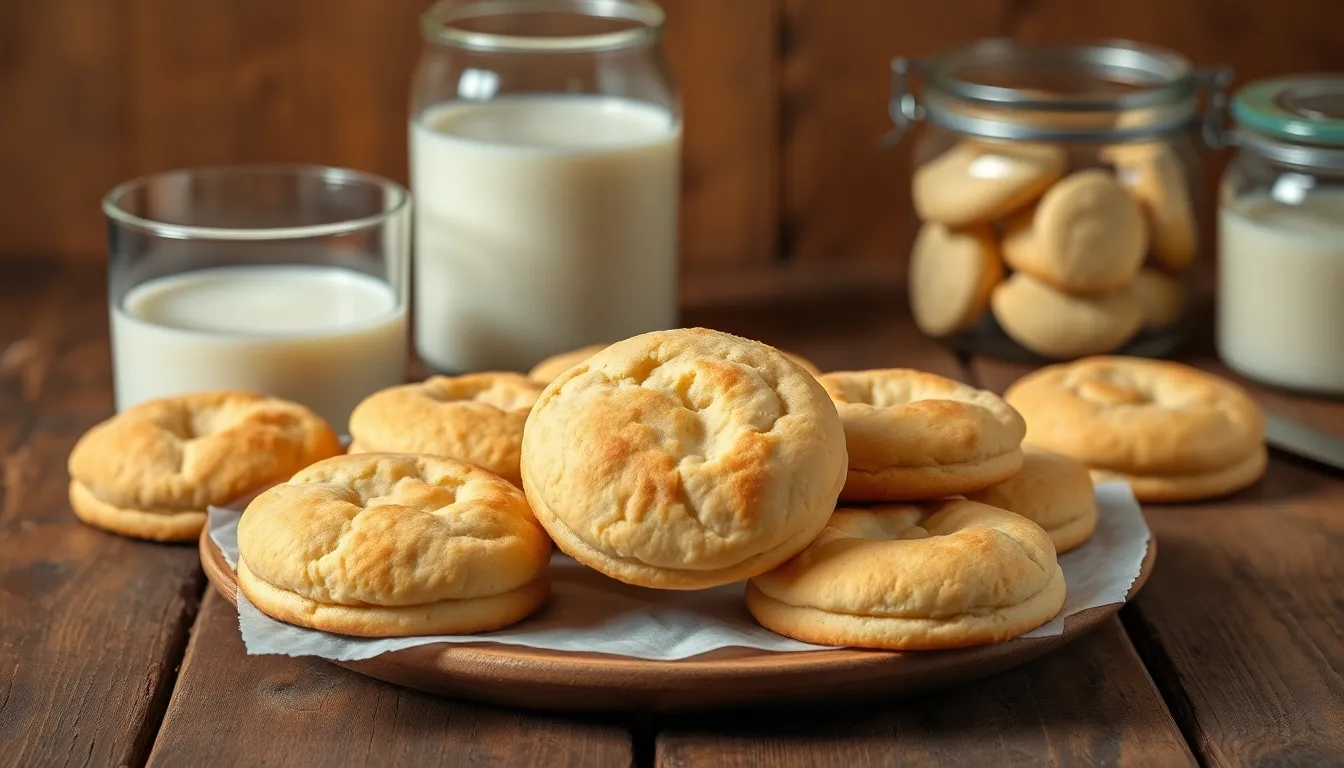
Proper storage keeps our 2 ingredient biscuits fresh and delicious for days after baking. We can store these fluffy treats using several different methods depending on how long we plan to keep them.
Room Temperature Storage
We recommend storing freshly baked biscuits in an airtight container at room temperature for optimal freshness. Our biscuits will maintain their soft texture and flavor for up to 3 to 4 days when stored this way. We should ensure the container seals completely to prevent moisture loss and maintain that tender crumb we worked so hard to achieve.
Refrigerated Storage
When we need to extend storage time beyond a few days, refrigeration offers an excellent solution. We can store our biscuits in the refrigerator for up to 1 week while maintaining their quality. This method works particularly well when we’ve made a large batch and want to enjoy them throughout the week.
Freezing Options
Freezing provides the longest storage option for our 2 ingredient biscuits. We have two distinct approaches depending on whether we freeze them before or after baking.
| Storage Method | Duration | Temperature | Instructions |
|---|---|---|---|
| Room Temperature | 3-4 days | Room temp | Airtight container |
| Refrigeration | 1 week | Refrigerator | Sealed container |
| Frozen (Baked) | 3 months | Freezer | Cool completely first |
| Frozen (Unbaked) | 3 months | Freezer | Freeze 1 hour then bag |
Unbaked Biscuits: We can freeze our shaped biscuits before baking by placing them on a flat surface in the freezer for 1 hour. After they firm up, we transfer them to a freezer-safe bag or airtight container. When we’re ready to bake, we place the frozen biscuits directly in a 375°F oven and bake for about 20 minutes.
Baked Biscuits: We must allow our baked biscuits to cool completely before freezing. Once cooled, we place them in a freezer-safe bag or airtight container where they’ll keep for up to 3 months. We can thaw them at room temperature or overnight in the refrigerator when ready to serve.
Reheating Guidelines
Our stored biscuits taste best when properly reheated before serving. We can warm them in the microwave for quick results or use the oven to restore their original texture. The oven method works particularly well for maintaining that crispy exterior and fluffy interior we love about fresh biscuits.
Using fresh ingredients initially ensures our biscuits maintain their light and fluffy texture throughout the storage period. This attention to ingredient quality pays dividends when we reheat and serve our stored biscuits days or even months later.
Troubleshooting Common Issues

Even with our simple two-ingredient recipe, we sometimes encounter challenges that can affect the final result. Understanding these common problems helps us achieve perfect biscuits every time.
Overworked Dough Leading to Tough Biscuits
We often see home bakers mixing the dough too vigorously or for too long. This overworking develops the gluten in the flour and creates tough, dense biscuits instead of light, fluffy ones. When we combine the self-rising flour and heavy cream, we should stir just until no dry flour remains visible. The dough will look shaggy and slightly lumpy, which is exactly what we want.
Managing Sticky Dough
Our two-ingredient biscuit dough tends to be stickier than traditional recipes because of the high moisture content from the heavy cream. We recommend dusting our work surface generously with flour before turning out the dough. Also, we should flour our hands and any cutting tools to prevent the dough from sticking. If the dough becomes too sticky to handle, we can add a tablespoon of flour at a time until it becomes manageable.
Preventing Biscuits from Crumbling
Crumbly biscuits typically result from incorrect ingredient ratios or improper mixing techniques. We must ensure we use the proper 2:1 ratio of flour to cream by weight for optimal structure. When our biscuits fall apart easily, we may have added too much flour or mixed the ingredients inadequately. The solution involves gently pressing the dough together and ensuring all flour gets incorporated without overworking.
Addressing Uneven Rising
Sometimes our biscuits rise unevenly or not at all. This issue often stems from expired self-rising flour that has lost its leavening power. We should always check the expiration date on our flour before baking. Fresh self-rising flour contains active baking powder that creates the lift we need. If we suspect our flour is old, we can test it by mixing a small amount with water to see if it bubbles.
Fixing Dense or Heavy Texture
Dense biscuits usually occur when we use warm cream instead of cold cream. The cold temperature helps create steam during baking, which contributes to the light, flaky texture. We should always use heavy cream straight from the refrigerator. Room temperature cream won’t provide the same results and can lead to disappointingly heavy biscuits.
Conclusion
We’ve shown you how just two simple ingredients can transform your baking routine forever. These biscuits prove that exceptional results don’t require complicated techniques or lengthy ingredient lists.
Whether you’re serving them alongside a hearty soup or creating an elegant brunch spread they’ll quickly become your go-to recipe. The versatility we’ve explored means you’ll never run out of delicious ways to enjoy them.
With proper storage techniques and our troubleshooting tips you’re equipped to create perfect biscuits every single time. We’re confident this recipe will earn a permanent spot in your kitchen repertoire and bring joy to countless meals ahead.
Frequently Asked Questions
What ingredients do I need for 2-ingredient biscuits?
You only need 2 cups of self-rising flour and 1 cup of cold heavy cream. That’s it! The self-rising flour provides the leavening agent, while the cold heavy cream adds richness and creates the tender texture. Make sure to check that your self-rising flour is fresh and hasn’t expired for the best results.
How long does it take to make these biscuits?
The entire process takes about 20 minutes total – 5 minutes to mix the ingredients and 15 minutes to bake. This makes them perfect for busy weeknights or when unexpected guests arrive. The simplicity of the recipe means you can have fresh, warm biscuits on the table in no time.
Can I make these biscuits without self-rising flour?
Yes! You can substitute self-rising flour by mixing 2 cups of all-purpose flour with 2 teaspoons of baking powder and 1 teaspoon of salt. However, using actual self-rising flour will give you the best and most consistent results for this simple recipe.
What kitchen equipment do I need?
You’ll need minimal equipment: a large mixing bowl, a spoon or whisk, a baking sheet, parchment paper, and an oven. No special tools like pastry cutters or rolling pins are required, making this recipe accessible to everyone regardless of their kitchen setup.
What temperature should I bake the biscuits at?
Preheat your oven to 500°F (260°C) and bake for 10-12 minutes until golden brown. The high temperature creates a nice rise and golden exterior while keeping the inside tender and fluffy. Serve immediately for the best texture and warmth.
Why is my biscuit dough so sticky?
Sticky dough is normal with this recipe! The high moisture content from the heavy cream creates the tender texture. Simply dust your work surface and hands with flour to manage the stickiness. Avoid adding too much extra flour, as this can make the biscuits dense.
Can I add flavors to these basic biscuits?
Absolutely! For sweet biscuits, add 2 tablespoons of sugar. For savory options, try adding shredded cheese, fresh herbs, garlic powder, or paprika. Mix any additions gently into the flour before adding the cream to maintain the tender texture.
How should I store leftover biscuits?
Store biscuits in an airtight container at room temperature for 3-4 days, or refrigerate for up to 1 week. For longer storage, freeze for up to 3 months. To reheat, wrap in foil and warm in a 350°F oven for 5-10 minutes to restore their fluffy texture.
Why didn’t my biscuits rise properly?
Poor rising usually results from expired self-rising flour, overmixing the dough, or using warm cream instead of cold. Always check your flour’s expiration date, mix just until combined, and use cold heavy cream straight from the refrigerator for the best rise.
What’s the best way to cut the biscuits?
Use a sharp knife or biscuit cutter with straight downward pressure – don’t twist! Twisting seals the edges and prevents proper rising. Pat the dough to about ½ inch thick, fold it once for extra flakiness, then cut straight down for perfectly risen biscuits.


